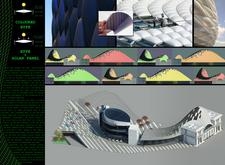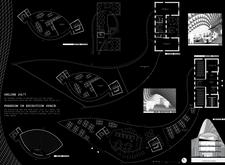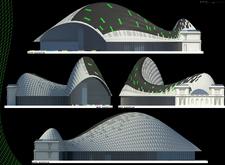5 key facts about this project
The London Internet Museum is situated in the heart of London and is conceived as a space that explores the evolution of the Internet alongside its cultural and technological ramifications. The design reflects the interconnectedness intrinsic to digital networks, aiming to provide an environment conducive to community engagement and education.
### Spatial Strategy
The layout of the museum is designed to emulate a non-linear browsing experience, reminiscent of Internet navigation. Exhibition areas are intentionally configured to promote fluid movement and exploration, allowing visitors to interact with displays and engage with one another. The architecture features a dynamic roof structure that serves as a unifying element, facilitating movement between different spaces while echoing the conceptual framework of connectivity.
### Material Selection and Sustainability
The project employs a diverse range of materials that enhance its visual and functional characteristics. Notably, ETFE (Ethylene Tetrafluoroethylene) is used in the roof, allowing natural light to infiltrate the interior while maintaining energy efficiency. Coloured ETFE film integrated with solar technology adds both aesthetic appeal and sustainability. The strategic use of glass in the façades fosters transparency and interaction with the surroundings, while steel is employed for its structural integrity, supporting the curvilinear forms of the design. This combination of materials not only underscores the building’s modern identity but also addresses contemporary environmental considerations.






















































